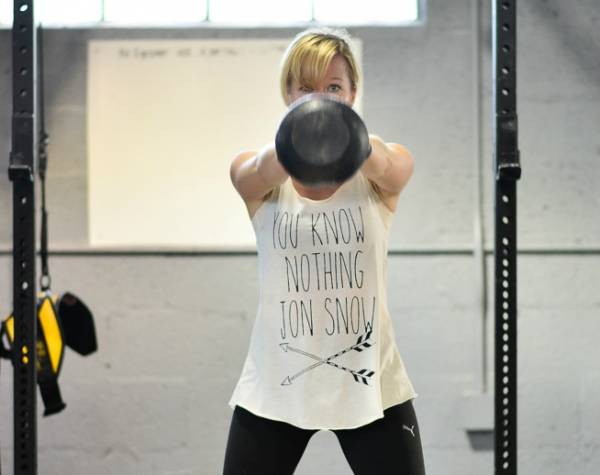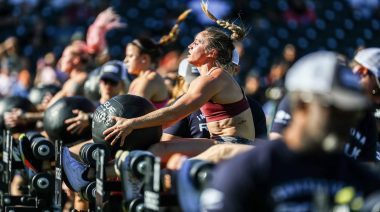Back in about 2010, I discovered OPT (now OPEX) training as an alternative to straight-up CrossFit. The Optimum Performance Training system, created by the first CrossFit Games winner James FitzGerald, was different than what we CrossFit puritans were used to. It was, for lack of a better description, CrossFit dissected.
In the Old Days of CrossFit
In those days, most gyms’ programming looked much like today’s main site. Every day you had one thing – a WOD. If you happen to follow main site, you still get this. If you belong to or run a gym that essentially does this same thing, i.e. a daily WOD, you’re doing old-school CrossFit like Greg Glassman invented.
This is what we were used to in 2010, and OPT training looked much different. There was part A, part B, sometimes a C1 and a C2, then maybe an EMOM, then a short four- to six-minute conditioning piece. There was no WOD – this whole stew of different parts was the “WOD.”
OPT took what we knew as a typical CrossFit workout and broke it down into pieces, for different purposes. One of those pieces was rest, and it occurred during the workout itself. That’s right – built-in rest.
In 2010, this was a fairly unusual concept. Besides “Fight Gone Bad” and “Barbara,” there were no CrossFit workouts where rest was actually a part of the plan. I remember programming a workout for the class that included rest after each round and there was some pushback from the clients. One person commented, “It just doesn’t seem like CrossFit if there’s rest.”
“Some people see EMOMs (every minute on the minutes) as a bunch of rest. I see them as an opportunity to train skills in a structured way.”
That is correct. It doesn’t.
I have long preached against the day-after-day ass-whoopin’ that comes with metcon after metcon for myriad reasons, but namely plateau and injury potential. And while I do understand the lure of the WOD from a community standpoint, I am a firm believer there is value to a training method that looks at a different way to approach your goals without getting beaten down.
Enter the concept of “rest.” Let’s take a look at some of the purposes of resting during workouts.
Beatdown Avoidance
Lots of things can happen when you do a daily good-old metcon. Boxes that program a twenty-minute metcon every day or some kitchen-sink shit-show will end up with overtrained, injured, and plateaued clients. It’s all fun and games until you stop making gains.
Intensity
Think about what happens with a workout like “Helen” – 3 rounds of 400m run, 21 kettlebell swings, and 12 pull ups. If you do “Helen” as written, you will experience a decrease in intensity with each round, because you are slowly, but surely depleting your battery’s charge. Once you begin to fatigue, there is no practical way for you to refuel your battery cells except for rest. In addition, you are more than likely saving something in the tank for the second and third rounds, so you’re performing at a less than 100% effort from the get-go.

Now imagine what might happen if you did this:
- 400m run
- 21 kettlebell swings
- 12 pull ups
- Rest 3:00 between rounds
Not only would you be able to do round one at a higher intensity, but you would also be able to do successive rounds at nearly the same effort. Odd as it sounds, you would actually be able to train harder with programmed rest.
“Rather than just a daily tank-emptying WOD, consider how built-in rest is just as powerful a tool as ‘AMRAP.’”
The benefits of this kind of training are wide and varied – from discovering the edge of your red line and understanding how that line affects your performance, to determining how quickly you recover, to being able to push yourself. In addition, you’ll begin to understand the concept of training systems – your creatine-phosphate system, glycolytic system, and aerobic system – in different ways. (That is a discussion for a much longer article but it’s important.)
Pacing Management
The nice thing about rest within a workout is that you can train pacing. With a traditional CrossFit workout, your pace is often “as fast as you can go without collapsing.” But think about approaching a workout like this:
5 rounds:
250m run
3 muscle ups
6 burpees
9 wall balls
Rest 2:00
Goal: even times across all rounds
In other words, you want to achieve the maximum sustainable time across all rounds. This requires you to recover fully before you begin the next round. This kind of work helps you develop pacing strategies by allowing you to not only understand what type of effort and fuel burn goes into a single round, but also understand how certain movements affect the movements that follow.
If you just did the above workout as five rounds for time, then it would be impractical or even impossible to note how you felt during each round, your time for each round, how well you recovered between rounds, how you felt going into the next round, and so on. Understanding how you burn fuel, how well you recover, and how you perform under fatigue is important in being able to compete at a higher level.

Skill Development
Some people see EMOMs (every minute on the minutes) as a bunch of rest. I see them as an opportunity to train skills in a structured way. Imagine a ten-minute EMOM of fifteen unbroken wall balls (unpleasant for sure). Each round you can focus on technique and how to optimize the squat, release, and catch. You can look at each round as a training exercise that will ultimately make your “Karen” time much faster. While you can certainly try to accomplish this by doing “Karen” once a week, chances are you’ll have little actual feedback about how your approach or technique is improving.
“Boxes that program a twenty-minute metcon every day or some kitchen-sink shit-show will end up with overtrained, injured, and plateaued clients.”
A built-in rest period gives you an opportunity to work skills in more than just a free-form way. Rest provides you with more structure, without the pressure of competing for time, counting your number of rounds, or blowing through reps without any attention to technique. The rest assures you will be able to stay in the game, fresh for each new round, without getting too fatigued to make skill development a part of your training session.
The Value of Rest
There are many more reasons why rest can be a valuable element of your programming, and not just a break from it. It’s the same as looking at rest days and recovery as a part of your training, not just what happens when you’re not training.
Rather than just a daily tank-emptying WOD, consider how built-in rest is just as powerful a tool as “AMRAP.”
Check out these related articles:
- The Importance of Respecting the CrossFit Process
- EMOMs – the Most Misunderstood Method In CrossFit
- 6 Practical Tips for Prioritizing Quality In CrossFit
- What’s New On Pulse Beat Fit Today
Photo 1 courtesy of Pulse Beat Fit.
Photos 2 and 3 courtesy of CrossFit Empirical.






